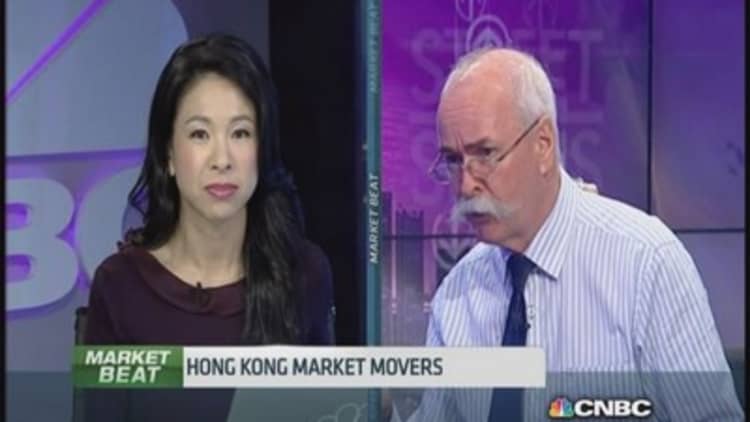Asian shares traded mixed on Tuesday as fears of global economic weakness affected investor sentiment. Tokyo was the region's worst performer, as a stronger currency weighed on the key Nikkei index.
U.S. stocks plunged on Monday, following declines in energy and airline shares amid growing fears over the spread of Ebola. The S&P 500 shed 1.7 percent, down 7 percent from the all-time high it set nearly four weeks ago and falling below its 200-day moving average. The fell 1.3 percent while the tech-heavy Nasdaq dropped 1.5 percent.
Read MoreDow correction has more room to move
Tokyo dives 2.4%
Japanese shares widened losses to finish Tuesday at a fresh two-month low of 14,936, as the yen hovered near 107.1 against the greenback. The benchmark Nikkei index was shut for a national holiday on Monday.
Exporters languished for most of the session; Sharp sank nearly 5 percent while Toyota Motor and Nissan Motor dropped 3.9 and 2 percent each. Index heavyweight Softbank also finished 3.2 percent lower.
Takashimaya bucked the losing trend to edge up 0.1 percent, after the department store hiked its full-year operating profit to 916 billion yen for the year through February.
Read MoreFour most worrying drags on global markets
Mainland shares down
China's Shanghai Composite index slipped back into the red on late Tuesday, after reversing opening losses in the morning session following the lower guidance rate from the Chinese central bank. This was the third straight session of losses for Shanghai equities.
The real estate sector remained weak despite new supportive measures from Beijing. According to state media Xinhua, borrowing costs were scrapped for property buyers who borrow from the government's borrowing fund. However, property majors like Poly Real Estate tanked 1.4 percent.
Hong Kong stocks also fell back into negative territory, finishing 0.4 percent lower on Tuesday. Earlier in the session, the Hang Seng index touched a near one-week high of 23,409.
Meanwhile, police operations were underway to clear protest barriers in the city's Central district.

Sydney jumps 1%
A recovery in the resources space helped Australia's key index to outperform the region, overlooking a National Australia Bank survey which showed the country's business conditions in September falling to its lowest in four months.
Atlas Iron and Mount Gibson were the top gainers on the back of higher spot iron ore, closing up 15 and 18 percent each. Fortescue Metals piled on 6 percent as well. "The local market is enjoying a relief rally today. A jump in iron ore prices sparked a round of short covering for the beaten-down iron ore plays," wrote IG's market strategist Stan Shamu in a note.
Copper and gold miner Oz Minerals rose 7.6 percent after it announced that production from its major Prominent Hill mine was on track to meet full-year guidance.
Wotif.com Holdings trimmed losses to close down 0.3 percent. The online travel firm hit a three-week low in morning trade after the New Zealand Commerce Commission said it has briefly delayed its regulatory ruling on Expedia's acquisition of the company.
Meanwhile, the Australian dollar staged a rebound on late Tuesday, edging up 0.2 percent to $0.8787 against the greenback.
Read MoreChina is our topconcern: Indonesia finance chief
Seoul up 0.1%
South Korea's KOSPI index snapped a three-day losing streak to close up slightly above a new seven-month closing low on Monday.
Oil refiners outperformed the bourse on prospects of higher margins; SK Innovation and S-Oil scaled over 3 and 2 percent each. Blue-chip Samsung Electronics advanced 1.7 percent.
Read MoreIs property a major risk for Singapore's economy?
Singapore flat
The Straits Times index fell back into the red on late Tuesday. Latest data showed the city-state expanded 2.4 percent in the third quarter from the year-ago period, missing a Reuters forecast for a 2.8 percent gain and following a rise of 2.4 percent rise in the previous quarter.

